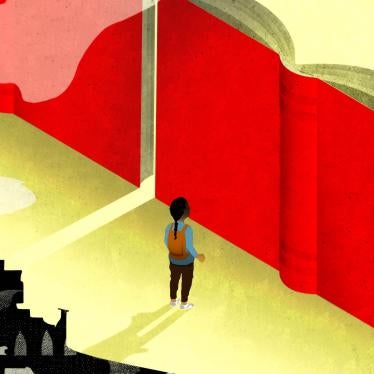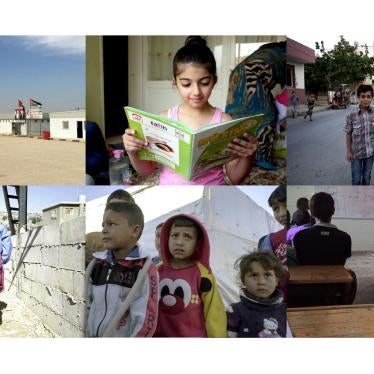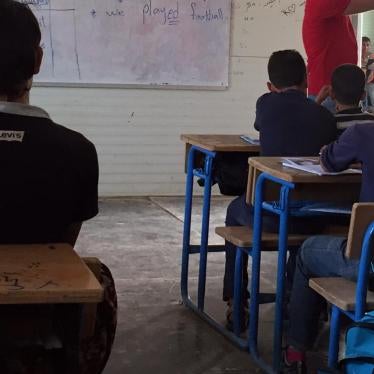Mr. Josep Borrell Fontelles
High Representative of the Union for Foreign Affairs and Security Policy
Vice-President of the European Commission
Mr. Olivér Várhelyi
Commissioner for Neighbourhood and Enlargement
Mr. Janez Lenarčič
Commissioner for Crisis Management
Ms. Jutta Urpilainen
Commissioner for International Partnerships
RE: Call to Support Access to Secondary Education for Syrian Refugee Children
Dear High Representative,
Dear Commissioners,
We are writing to encourage your continued financial and policy support to education for all refugee children in Jordan, Lebanon, Turkey, and Iraq; to bring to your attention the need for more effective action on behalf of secondary-school aged refugee children; and to ask you to specifically address the secondary education needs of refugee children at the 4th Brussels Conference on Supporting the Future of Syria and the Region hosted by the European Union and scheduled for 29 and 30 June 2020, and other appropriate opportunities.
As the Syria conflict enters its 10th year, the devastating fact is that the vast majority of Syrian refugee children have no hope of going to secondary school, and this will impact them for life. Failure to provide secondary education not only "kicks away the ladder" to vocational and higher education, it puts children in greater danger of child labor, crime and child recruitment, and child marriage.[i] It is difficult to overstate the importance of reversing this massive deprivation. A quality education, including secondary school, can be a refugee child's best chance to escape from poverty, find decent work, and actively participate in their society.
Based on available figures, out of the 390,000 Syrian refugee children in the region who should be in upper-secondary education, more than 300,000 are not enrolled:[ii]
- In Turkey, enrollment rates decline from more than 95 percent at primary school level to less than 27 percent at the upper-secondary level, or only 72,000 of 270,000 children ages 14 to 17.[iii]
- In Iraq, with 69,000 school-age Syrian refugee children, enrollment rates in camps fall from 51 percent in primary education to 29 percent in upper-secondary, and for children outside the camps, enrollment falls from 29 percent in primary to just 8 percent in secondary education.[iv]
- In Jordan, fewer than 7,000 of more than 27,000 Syrian refugee adolescents are enrolled in secondary education, according to the education ministry.[v] More detailed findings show even worse outcomes: only 15 percent of 16-year-old Syrian children in Jordan are enrolled in school, a Fafo survey found.[vi]
- In Lebanon, where there are roughly 80,000 registered Syrian refugee adolescents ages 15 to 18[vii], fewer than 4 percent are enrolled in secondary education, according to a 2019 evaluation of the European Commission's "Madad" Trust Fund's support for Syrian refugee education.[viii]
The right to education, under international law, includes the right to access secondary education for all children, regardless of their refugee or immigration status. Education programming for Syrian refugee children has not reflected this right and urgency. Instead of badly-needed improvements, education plans have actually reduced secondary-enrollment targets for refugee children:
- In Iraq in 2019, the humanitarian education sector's "target indicator" was that 12,953 Syrian refugee children should be in secondary education, out of a total school-age population of almost 64,000 children.[ix] In 2020, the secondary enrollment target decreased to 10,033.[x] For 2021, the target is to enroll 2,180 Syrian refugee children in secondary education, even though the refugee population remains nearly the same; Iraq hosts nearly 25,000 Syrian refugee children ages 12 and older, half of whom may be of upper-secondary-school age.[xi]
- In 2015, UNESCO planned to support 10,000 Syrian refugee students to obtain secondary education in Lebanon, and another 10,000 in Jordan.[xii] In Lebanon, the current education plan to respond to the influx of Syrian students envisions enrolling only 4,907 "non-Lebanese" children, including Syrians, in secondary education by 2021, and another 2,500 non-Lebanese students in vocational training.[xiii] Even if all of these "non-Lebanese" spaces were filled by Syrian students, the plan would exclude more than 90 percent of Syrian adolescents.[xiv]
- In Jordan, government planning documents have noted that only a tiny fraction of Syrian students complete their secondary school examinations and that secondary-school enrollment rates are 47 percent lower for Syrian than Jordanian children, but education plans for Syrian refugee children do not currently commit to specific secondary-school enrollment targets.[xv]
International donors have given substantial contributions to refugee education but have not focused adequate attention on the lack of access at the secondary level and the obstacles that are depriving an entire generation of Syrian refugee children of their rights to education, the ability to develop their talents, and the chance to embark on a future based on knowledge and informed choices. The European Commission's "Madad" Trust Fund, for example, had given more than €160 million for education in Jordan, and €346 million for education and child protection in Lebanon, as of November 2018.[xvi] But while the Madad Fund supports "basic education," including lower-secondary education, as well as "higher education",[xvii] it does not target upper-secondary education.[xviii] The Commission, additionally, has given budget support to Jordan's education ministry.[xix] The EU Facility for Refugees in Turkey, by contrast, includes secondary education as one of the targets of €500 million allocated for education in 2018.[xx]
The doors to secondary school have already closed forever for hundreds of thousands of Syrian refugees. Children who drop out of education often have no real chance to return to formal learning, yet there are few meaningful informal alternatives. The lack of a dedicated focus on supporting education for secondary-age refugee children means there are too few programs available that offer pathways to certified education or vocational education and skills training.
We call on you, your EU partners, and other like-minded actors to recognize the urgency of this education crisis, and to ensure that adequate funding and concrete actions are directed to fulfil the rights of all Syrian refugee children to access quality secondary education. Their future is hanging in the balance.
We thank you for your attention to this urgent and important matter, and we stand ready to provide further information about our research in this regard.
Sincerely,
Zama Neff Lotte Leicht
Children's Rights Director EU Director
CC:
Head of Cabinet of the High Representative for Foreign Affairs and Security Policy, Mr Pedro Serrano de Haro
Member of Cabinet of the High Representative for Foreign Affairs and Security Policy, Ms Fiona Knab-Lunny
Head of Cabinet of the Commissioner for Neighbourhood and Enlargement, Mr László Kristóffy
Member of Cabinet of the Commissioner for Neighbourhood and Enlargement, Mr László Andrejkó
Head of Cabinet of the Commissioner for International Partnerships, Mr Taneli Lahti
Member of Cabinet of the Commissioner for International Partnerships, Mr Renaud Savignat
Head of Cabinet of the Commissioner for Crisis Management, Mr Matjaž Malgaj
Member of Cabinet of the Commissioner for Crisis Management, Ms Adela Kabrtova
Secretary General of the European External Action Service (EEAS), Ms Helga Maria Schmid
Deputy Secretary General for Political Affairs, Political Director, EEAS, Mr Enrique Mora Benavente
Deputy Secretary General for Economic and Global Issues, EEAS, Mr Stefano Sannino
European Union Special Representative for Human Rights, Mr Eamon Gilmore
Managing Director for Human Rights, Global and Multilateral Issues, EEAS, Ms Lotte Knudsen
Head of Division, Migration and Human Security, EEAS, Ms Christine Grau
Managing Director for Middle East and North Africa (MENA), EEAS, Mr Fernando Gentilini
Head of Division for Middle East I - Egypt, Syria, Lebanon, and Jordan, EEAS, Ms Erika Ferrer
Head of Division for the Arabian Peninsula, Iraq and Regional Policies, EEAS, Mr Gabriel Munuera Vinals
Director General of European Civil Protection and Humanitarian Aid Operations (DG ECHO), Ms Paraskevi Michou
Deputy Director General of DG ECHO, Mr Michael Koehler
Director of Neighbourhood and Middle East, DG ECHO, Mr Andreas Papaconstantinou
Head of Unit for Middle East, DG ECHO, Mr Juha Auvinen
Team Leader on the Syria Regional Crisis, DG ECHO, Mr Mamar Merzouk
Director General for Neighbourhood and Enlargement Negotiations (DG NEAR), Mr Christian Danielsson
Deputy Director of DG NEAR, in charge of Southern Neighbourhood, Turkey, Migration/Refugees and Security Issues, Mr Maciej Popowski
Head of Unit for Middle East at DG NEAR, Mr Michael Miller
Director General for International Cooperation and Development (DG DEVCO), Mr Koen Doens
Head of Unit for Middle East, Central Asia, South Asia, DG DEVCO, Ms Raffaella Iodice
Head of Unit for Gender Equality, Human Rights and Democratic Governance, DG DEVCO, Ms Chiara Adamo
[i] Filippo Grandi, "Introduction," Stepping Up: Refugee Education in Crisis, UNHCR 2019, https://www.unhcr.org/steppingup/ (accessed May 4, 2020).
[ii] Human RIghts Watch estimates based on available UN and host-country data. Before the conflict, nearly 70 percent of Syrian children attended secondary school. "Accessing education in the midst of the Syria crisis," Norwegian Refugee Council, April 26, 2018, https://www.nrc.no/news/2018/april/accessing-education-in-the-midst-of-the-syria-crisis/ (accessed May 4, 2020).
[iii] Evaluation of EUTF-funded Programmes/Projects on Basic Education: Final Report, Particip Consortium, December 2019, p. 221, Table 3, https://ec.europa.eu/trustfund-syria-region/sites/tfsr/files/eutf_be_evaluation_report_final_17_dec_2019.pdf (accessed May 5, 2020). See also Monitoring Report, The Facility for Refugees in Turkey, November 2019, p. 6, https://ec.europa.eu/neighbourhood-enlargement/sites/near/files/facility_results_framework_monitoring_report.pdf
[iv] Iraq: Regional Refugee & Resilience Plan in Response to the Syria Crisis 2020-2021, February 2020, p. 35, https://www.humanitarianresponse.info/sites/www.humanitarianresponse.info/files/documents/files/2020-2021_3rp_iraq_chapter.pdf (accessed May 5, 2020).
[v] In the last quarter of 2019, 6,936 out of an estimated 27,300 Syrian children in the upper-secondary-school-age range, or about 25 percent, were enrolled in grades 11 and 12. "Education Quarterly Dashboard, Q4 2019 (Oct - Dec 2019)," Inter-Sector Working Group Jordan, p.2, https://reliefweb.int/sites/reliefweb.int/files/resources/73977.pdf (accessed April 28, 2020). In 2017-2018, education ministry data showed 24 percent of Syrian refugee students were enrolled in grades 11-12. We Made A Promise: Ensuring Learning Pathways and Protection for Children and Youth, No Lost Generation, April 2018, p. 29, https://www.nolostgeneration.org/article/nlg-education-report-we-made-promise (accessed April 29, 2020). The Ministry of Education's Open EMIS data portal reports that 20.36 percent of Syrian children were enrolled in secondary school, apparently in 2016-2017, https://jo-moe.openemis.org/data/emergencyedu/index.html (accessed April 28, 2020).
[vi] Tiltnes, Zhang and Pederson, The living conditions of Syrian refugees in Jordan: Results from the 2017-2018 survey of Syrian refugees inside and outside camps, Fafo and Jordanian Ministry of Planning and International Cooperation, p. 80, https://reliefweb.int/sites/reliefweb.int/files/resources/67914.pdf (accessed April 28, 2020).
[vii] Lebanon's education ministry reported that in 2018-2019 there were 4,903 "non-Lebanese" children enrolled in secondary education. In 2017-2018, there were 2,709 Syrians out of 3,600 "non-Lebanese" students in secondary education; in 2015-2016, there were 1,200 Syrians out of 2,200 "non-Lebanese". "RACE II PMU September 2019 Factsheet," Lebanon Ministry of Education and Higher Education, p.2, http://racepmulebanon.com/images/RACE-PMU-Fact-Sheet-September-2019.pdf (accessed April 29, 2020); El-Ghali, Alameddine, Farah and Benchiba, Pathways to and Beyond Education for Refugee Youth in Jordan and Lebanon, American University of Beirut: Issam Fares Institute, March 2019, p. 19 (citing education ministry), https://www.aub.edu.lb/ifi/Documents/publications/research_reports/2018-2019/20190305_pathway_to_and_beyond_education.pdf (accessed April 29, 2020); Human Rights Watch, "Barriers for High-Risk Populations," "Growing Up Without an Education: Barriers to Education for Syrian Refugee Children in Lebanon," August 2016, https://www.hrw.org/report/2016/07/19/growing-without-education/barriers-education-syrian-refugee-children-lebanon#aef602.
[viii] Evaluation of Madad-funded Programmes / Projects for Higher Education: Draft Evaluation Report, Particip Consortium, November 2018 p. 68, https://ec.europa.eu/trustfund-syria-region/sites/tfsr/files/eutf_hedu_evaluation_report_0.pdf. In 2018, the EU noted that fewer than three per cent of registered Syrian refugees, ages 15-18, were enrolled in public secondary schools, and around the same fraction in Technical Vocational (TVET) public schools. "Action Document for EU Trust Fund to be used for the decisions of the Operational Board," Ref. Ares (2018) 4626764, September 10, 2018, p. 7, https://ec.europa.eu/neighbourhood-enlargement/sites/near/files/eutf_final_ad_education_lebanon_revised_after_the_june_board_2018.pdf (accessed April 28, 2020).
[ix] "3RP Country Chapter: Iraq," Regional Refugee and Resilience Plan in Response to the Syria Crisis 2019-2020, pp. 40, 42, https://data2.unhcr.org/en/documents/download/69209
[x] Id., p. 42.
[xi] "Iraq," Regional Refugee & Resilience Plan in Response to the Syria Crisis 2020-2021, February 2020, p. 40. Demographic data compiled from "Syria Regional Refugee Response: Iraq," UNHCR, https://data2.unhcr.org/en/situations/syria/location/5 (accessed May 5, 2020). Lower secondary school in Iraq begins after 6 years of primary education.
[xii] Bridging Learning Gaps for Youth: UNESCO Education Sector Response to the Syria Crisis 2015-2016, p. 16, https://www.cois.org/uploaded/Blog/Jane-Rufugee-Crisis/UNESCO_EDUCATION_SECTOR_Response_to_the_Syrian_Crisis_in_Jordan,_November_2013.pdf (accessed April 28, 2020).
[xiii] Reaching All Children with Education (RACE II), part of the overall Lebanon Crisis Response Plan. "Annexe I: RACE II Logframe," Lebanon Ministry of Education and Higher Education, p. 1, August 29, 2016, http://racepmulebanon.com/images/RACE-II_FINAL-LOGFRAME_29AUG2016.pdf (accessed April 28, 2020).
[xiv] The updated Lebanon Crisis Response Plan aims for more than 52 percent of the Syrian children who begin class 7 to complete class 9 (the "third cycle" of compulsory primary education) but does not state secondary enrollment targets. Lebanon Crisis Response Plan 2017-2020 (2020 Update), March 2020, p. 70, https://reliefweb.int/sites/reliefweb.int/files/resources/74641.pdf (accessed April 28, 2020).
[xv] The plans do include Key Performance Indicators related to secondary education. Only 1,605 Syrian students took the Jordanian general secondary school examination in 2015-2016, and only 536 passed. The plan's objectives refer to secondary education in regard to funding requests to build new schools. Jordan Response Plan for the Syria Crisis 2017-2019, pp. 67, 63, https://reliefweb.int/sites/reliefweb.int/files/resources/JRP%2B2017-2019%2B-%2BFull%2B-%2B%28June%2B30%29.pdf; Jordan Response Plan to the Syria Crisis 2018-2020, p. 60, https://jordankmportal.com/resources/jordan-response-plan-2018-2020 (accessed April 28, 2020). Jordan Population and Family Health Survey 2017-18, March 2019, cited in http://jordaningoforum.org/testsite/wp-content/uploads/Walk-The-Talk-Oct2019_FinalVersion.pdf (accessed April 28, 2020).
[xvi] "Responding to the Syrian Crisis: EU Support to Resilience in Jordan," European Commission, November 2018, p. 2 (€138 million were directed to basic education, and €22 million to higher education), https://ec.europa.eu/neighbourhood-enlargement/sites/near/files/near_jordan_factsheet_0.pdf; "Responding to the Syria Crisis: EU Support to Resilience in Lebanon," November 2018, p. 2, https://ec.europa.eu/neighbourhood-enlargement/sites/near/files/eu-support-to-lebanon-factsheet.pdf (accessed April 28, 2020). More recent EU aid figures are available but do not clearly disaggregate education funding, or otherwise appear to under-state the amount of education aid provided, e.g. a report that the Madad Fund as of April 2020 has provided UNICEF with €107.9 million for basic education in Lebanon, Jordan and Turkey, which does not appear to reflect all Madad education funding. Factsheet, April 2020, p. 2, https://ec.europa.eu/trustfund-syria-region/sites/tfsr/files/eutf-syria-factsheet-eng.pdf (accessed May 2, 2020).
[xvii] "EUTF Operational Results Framework," 2019, p. 1, https://ec.europa.eu/trustfund-syria-region/sites/tfsr/files/eutf_rf_2019.pdf (accessed April 28, 2020).
[xviii] Evaluation of EUTF-funded Programmes/Projects on Basic Education: Final Report, Particip Consortium, December 2019, p. 19, https://ec.europa.eu/trustfund-syria-region/sites/tfsr/files/eutf_be_evaluation_report_final_17_dec_2019.pdf (accessed May 10, 2020).
[xix] E.g. an additional €60 million in budget support for Jordan's education ministry using ENI funds for 2019-2020. "Commission Implementing Decision on the multiannual action programme 2019 and 2020 part I, in favour of the Hashemite Kingdom of Jordan," November 29, 2019, p. 1, https://ec.europa.eu/neighbourhood-enlargement/sites/near/files/c_2019_8748_jordan_aap_2019_2020_part_1_commission_implementing_decision_en_merged.pdf (accessed May 10, 2020).
[xx] "Commission Implementing Decision on the adoption of a special measure on education under the Facility for Refugees in Turkey," December 11, 2018, https://ec.europa.eu/neighbourhood-enlargement/sites/near/files/amendment_c_2018_8254_f1_commission_implementing_decision_en_v3_p1_1001796.pdf (accessed May 5, 2020); The Facility for Refugees Turkey: Monitoring Report, European Commission, November 2019, p. 6, https://ec.europa.eu/neighbourhood-enlargement/sites/near/files/facility_results_framework_monitoring_report.pdf (accessed May 4, 2020); The Facility for Refugees in Turkey: Monitoring Report, May 2019, p. 3, https://ec.europa.eu/neighbourhood-enlargement/sites/near/files/190607_facility-monitoring-report-final.pdf (accessed May 4, 2020).







